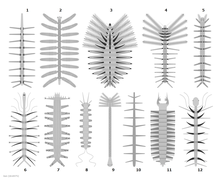
Back فصيات الأقدام Arabic Lobopodlar Azerbaijani Lobòpodes Catalan Lobopoden German Lobopodia Esperanto Lobopodia Spanish پهنپاتباران Persian Lobopodia Finnish Lobopodia French Lobopodia FRR
| Lobopodia Temporal range: Descendant taxa Onychophora, Tardigrada, and Euarthropoda survive to Recent, possible Ediacaran ichnofossils [2]
| |
|---|---|

| |
| Reconstruction of various lobopodians. 1: Microdictyon sinicum, 2: Diania cactiformis, 3: Collinsovermis monstruosus, 4: Luolishania longicruris, 5: Onychodictyon ferox, 6: Hallucigenia sparsa, 7: Aysheaia pedunculata, 8: Antennacanthopodia gracilis, 9: Facivermis yunnanicus, 10: Paucipodia inermis, 11: Jianshanopodia decora, 12: Hallucigenia fortis | |
| Scientific classification | |
| Domain: | Eukaryota |
| Kingdom: | Animalia |
| Subkingdom: | Eumetazoa |
| Clade: | ParaHoxozoa |
| Clade: | Bilateria |
| Clade: | Nephrozoa |
| Clade: | Protostomia |
| Superphylum: | Ecdysozoa |
| (unranked): | Panarthropoda |
| Phylum: | †"Lobopodia" Snodgrass 1938 |
| Groups included | |
| |
| Cladistically included but traditionally excluded taxa | |
|
Crown-group Euarthropoda | |
| Synonyms | |
| |
Lobopodians are members of the informal group Lobopodia[3] (from the Greek, meaning "blunt feet"), or the formally erected phylum Lobopoda Cavalier-Smith (1998).[4] They are panarthropods with stubby legs called lobopods,[5] a term which may also be used as a common name of this group as well.[6][7] While the definition of lobopodians may differ between literatures,[8] it usually refers to a group of soft-bodied, marine worm-like fossil panarthropods such as Aysheaia and Hallucigenia. However, other genera like Kerygmachela and Pambdelurion (which have features similar to other groups) are often referred to as “gilled lobopodians”. [9][5][10]
The oldest near-complete fossil lobopodians date to the Lower Cambrian; some are also known from Ordovician, Silurian and Carboniferous Lagerstätten.[11][12][13] Some bear toughened claws, plates or spines, which are commonly preserved as carbonaceous or mineralized microfossils in Cambrian strata.[14][15] The grouping is considered to be paraphyletic, as the three living panarthropod groups (Arthropoda, Tardigrada and Onychophora) are thought to have evolved from lobopodian ancestors.
- ^ Haug, J.T.; Mayer, G.; Haug, C.; Briggs, D.E.G. (2012). "A Carboniferous non-Onychophoran Lobopodian reveals long-term survival of a Cambrian morphotype". Current Biology. 22 (18): 1673–1675. Bibcode:2012CBio...22.1673H. doi:10.1016/j.cub.2012.06.066. PMID 22885062.
- ^ Chen, Zhe; Chen, Xiang; Zhou, Chuanming; Yuan, Xunlai; Xiao, Shuhai (6 June 2018). "Late Ediacaran trackways produced by bilaterian animals with paired appendages". Science Advances. 4 (6): eaao6691. Bibcode:2018SciA....4.6691C. doi:10.1126/sciadv.aao6691. hdl:10919/84444. PMC 5990303. PMID 29881773.
- ^ Snodgrass, R.E. (1938). "Evolution of the Annelida, Onychophora, and Arthropoda". Smithsonian Miscellaneous Collections. 97 (6): 1–159.
- ^ Cavalier-Smith, T. (1998). "A revised six-kingdom system of life". Biological Reviews. 73 (3): 203–266. doi:10.1017/S0006323198005167 (inactive 4 January 2025). PMID 9809012.
{{cite journal}}: CS1 maint: DOI inactive as of January 2025 (link) - ^ a b Ortega-Hernández, Javier (2015-10-05). "Lobopodians". Current Biology. 25 (19): R873 – R875. Bibcode:2015CBio...25.R873O. doi:10.1016/j.cub.2015.07.028. ISSN 0960-9822. PMID 26439350.
- ^ Budd, Graham; Peel, John (1998-12-01). "A new Xenusiid lobopod from the early Cambrian Sirius Passet fauna of North Greenland". Palaeontology. 41: 1201–1213.
- ^ Cite error: The named reference
Liu2006was invoked but never defined (see the help page). - ^ Cite error: The named reference
:8was invoked but never defined (see the help page). - ^ Liu, Jianni; Dunlop, Jason A. (2014-03-15). "Cambrian lobopodians: A review of recent progress in our understanding of their morphology and evolution". Palaeogeography, Palaeoclimatology, Palaeoecology. 398: 4–15. Bibcode:2014PPP...398....4L. doi:10.1016/j.palaeo.2013.06.008. ISSN 0031-0182.
- ^ Cite error: The named reference
:13was invoked but never defined (see the help page). - ^ van Roy, P.; Orr, P.J.; Botting, J.P.; Muir, L.A.; Vinther, J.; Lefebvre, B.; Hariri, K.E.; Briggs, D.E.G. (2010). "Ordovician faunas of Burgess Shale type". Nature. 465 (7295): 215–218. Bibcode:2010Natur.465..215V. doi:10.1038/nature09038. PMID 20463737. S2CID 4313285.
- ^ von Bitter, P.H.; Purnell, M.A.; Tetreault, D.K.; Stott, C.A. (2007). "Eramosa Lagerstätte—Exceptionally preserved soft-bodied biotas with shallow-marine shelly and bioturbating organisms (Silurian, Ontario, Canada)". Geology. 35 (10): 879. Bibcode:2007Geo....35..879V. doi:10.1130/G23894A.1. S2CID 11561169.
- ^ Haug, J.T.; Mayer, G.; Haug, C.; Briggs, D.E.G. (2012). "A Carboniferous non-Onychophoran Lobopodian reveals long-term survival of a Cambrian morphotype". Current Biology. 22 (18): 1673–1675. Bibcode:2012CBio...22.1673H. doi:10.1016/j.cub.2012.06.066. PMID 22885062.
- ^ Caron, J.-B.; Smith, M.R.; Harvey, T.H.P. (2013). "Beyond the Burgess Shale: Cambrian microfossils track the rise and fall of hallucigeniid lobopodians". Proceedings of the Royal Society B: Biological Sciences. 280 (1767): 20131613. doi:10.1098/rspb.2013.1613. PMC 3735267. PMID 23902914.
- ^ Topper, T.P.; Skovsted, C.B.; Peel, J.S.; Harper, D.A.T. (2013). "Moulting in the lobopodian Onychodictyon from the lower Cambrian of Greenland". Lethaia. 46 (4): 490–495. Bibcode:2013Letha..46..490T. doi:10.1111/let.12026.